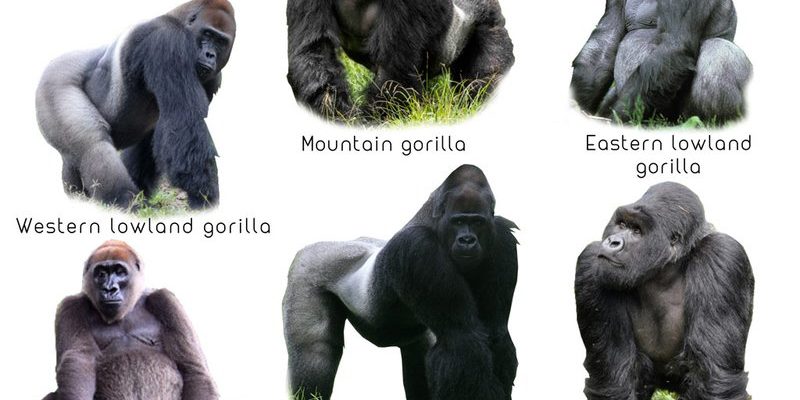![Comparing The Eastern Gorilla Vs. [Similar Species]](https://gudri.com/wp-content/uploads/2025/06/Comparing_The_Eastern_Gorilla_Vs___Similar_Species__image_0.jpg)
So, what sets these two apart? Picture the Eastern Gorilla as a family member who prefers the quiet, dense forests—while the Western Gorilla enjoys a more open and sociable environment. Both species play vital roles in their habitats, and understanding their differences can help us appreciate the complexity of wildlife conservation efforts. Let’s break down what makes each of these magnificent animals unique.
Physical Differences Between Eastern and Western Gorillas
When you look at gorillas, the first thing you might notice is their size. The Eastern Gorilla is generally larger than the Western Gorilla. Males of the Eastern species can weight up to 500 pounds, while their Western relatives typically max out around 400 pounds. Their body structure is notably robust, giving them a powerful appearance.
Another distinction lies in their fur. Eastern Gorillas often have darker fur that can appear almost black or deep brown, while Western Gorillas tend to have a lighter, grayish hue. This variation isn’t just a fashion choice; it helps them adapt to their specific environments. The Eastern Gorilla’s darker coat allows for better camouflage in dense forests.
Interestingly, their facial features differ too. Eastern Gorillas have broader noses and larger teeth compared to their Western cousins. This adaptation likely helps them eat the tougher vegetation found in their habitat. So, when you think about these two species, you can visualize them as kings of their respective realms, suited to the environments they call home.
Habitat and Range
Now, let’s talk about where these gorillas make their homes. The Eastern Gorilla mainly inhabits the dense forests of the Democratic Republic of the Congo, particularly in areas like the Virunga Mountains and the Kahuzi-Biéga National Park. Imagine walking through lush greenery, where the Eastern Gorilla blends into the shadows, foraging for leaves and fruit.
On the other hand, the Western Gorilla is more adaptable to varying habitats. They are found in the forests of western Central Africa, including countries like Cameroon and Gabon. Unlike their Eastern relatives, Western Gorillas can also thrive in swampy areas. This adaptability plays a significant role in their population dynamics, as they can often find food sources even when conditions change.
Understanding the habitats of these two species helps us see why conservation efforts are crucial. Their environments are threatened by deforestation and human activity, making it essential to protect these incredible places for the gorillas’ survival.
Dietary Preferences
When it comes to food, both species have similar diets, primarily consisting of leaves, stems, and fruits. However, the Eastern Gorilla tends to munch on tougher vegetation, which aligns with their larger size and stronger jaw structure. They often feast on various leaves and stems, which are abundant in their dense forest habitats.
In contrast, the Western Gorilla is known for its love of fruit. They can often be found in areas with plenty of fruit trees, enjoying a buffet of sweet treats. This preference not only satisfies their taste buds but also plays a role in seed dispersal, helping to rejuvenate their habitats.
So, here’s the thing: their diets directly reflect their environments. While both gorillas share a similar menu, their adaptations allow them to thrive in their unique niches within the forest ecosystem.
Behavioral Traits and Social Structure
Gorillas are known for their complex social structures, and both species exhibit fascinating social dynamics. The Eastern Gorilla tends to be more solitary compared to its Western counterpart. Males often roam alone or in small groups, while females and their young typically stay in tighter family units. This behavior might stem from their forested habitats, which can make it more challenging to find food in large groups.
In contrast, the Western Gorilla is more social. They often form larger family groups, complete with a dominant male, several females, and their offspring. The social interactions among them are rich, filled with grooming and play. This behavior fosters strong bonds within the group, essential for their survival.
Understanding these social dynamics is vital for conservationists. The more we know about how these gorillas interact, the better we can support their needs in the wild—whether that’s protecting their habitat or ensuring they have access to nutritious food sources.
Conservation Status and Challenges
Both the Eastern and Western Gorillas face significant threats due to habitat loss, poaching, and disease. The Eastern Gorilla is categorized as Critically Endangered, with population estimates showing a steep decline over the past few decades. Factors like illegal hunting and the impacts of civil unrest in their native regions have contributed to their plight.
Similarly, the Western Gorilla is also listed as Critically Endangered, with their populations suffering from similar threats. Additionally, they are vulnerable to diseases like Ebola, which can decimate entire groups.
This brings us to the harsh reality: conservation efforts for both species are essential. Programs focusing on habitat protection, anti-poaching initiatives, and community education are critical in ensuring these majestic animals can thrive in the wild.
Final Thoughts on Gorillas
In the grand tapestry of nature, comparing the Eastern Gorilla and Western Gorilla reveals so much about adaptation, survival, and the intricate web of life. While they share a common ancestry, their differences in size, habitat, behavior, and dietary preferences highlight the beauty of biodiversity. Each species plays a unique role in their ecosystem, reminding us of why conservation is vital.
So, the next time you think of these gentle giants, consider their struggles and the efforts to protect them. Gorillas are not just fascinating animals; they are a crucial part of our planet’s health and diversity. If we each do our part to support their conservation, we can help ensure future generations will continue to be inspired by their presence in the wild.

